Friday, November 27, 2009
Schlumbergera
Several are in full bloom now. Schlumbergera = "Holiday cactus" = "Thanksgiving cactus" = "Zygocactus" = sometimes, incorrectly, Xmas cactus
 Salmon, cutting-grown 4 years old. Summered outdoors, North side of house.
Salmon, cutting-grown 4 years old. Summered outdoors, North side of house.
 3 years old pink. Summered same as the others.
3 years old pink. Summered same as the others.
Labels:
Holiday Cactus,
Schlumbergera,
Zygocactus
Lost in Translation: Chinese signs
Some signs from my October trip to China. I think anyone would find these signs funny. To be fair, how many signs in the US are translated into Chinese? We get protests if signs are bilingual, with Spanish. So these signs acknowledge and welcome the foreign tourists. But they're still funny.




 Protect the ecological environment. Advocate the new civilization.
Protect the ecological environment. Advocate the new civilization.
Thursday, November 26, 2009
The Peach in Winter: Leaf Curl Prevention
This year's experiment with leaf curl prevention was so wildly successful, I didn't want to miss the opportunity to repeat it. So last weekend I did. Even if I don't get into the garden again for a month, I've done the most productive task.
I did the following:
1. Strip off remaining leaves. That's easy and fairly quick on these genetic dwarf peach varieties. They are compact, and the leaves come off easily. I strip off the leaves so that all of the spray goes on the stems, and so that they don't interfere with bundling the branches.
2. Rake up all debris, leaves, and weeds, under the trees.
3. Spray with copper spray. Copper is considered "organic" because it's a mineral. The concern is to over-do it, and have too much copper in the soil. So I was careful not to over-do it.
4. Bundle the branches into compact packages that would be easy to cover with white plastic garbage bags. I chose white plastic because it is somewhat reflective, to keep the branches from overheating.
5. Cover the bundled branches with the plastic bags.
6. Tie the bags into place.
7. Prune off any little branches that did not fit into this scheme.
My worries last year were that this process would damage the trees. It did not - this year I had the best peach crop ever, with only about 10 leaves impacted by leaf curl disease. Click on the labels to see the devastating effects of that infection. It's the reason people keep telling me "you can't grow peaches here"
I also sprayed the Moorman apricot and the potted dwarf apricot, that I will move into better shelter soon. I don't know if that will help - apricots tend to die quickly here, and I have not figured out why, yet.
Orchid experiment
With so many orchids available, I've been tempted into buying some. Over the past few months, I've added several. The flowers last weeks, even months, so if they don't re-bloom, it's not a total loss. Still, I hope they do, and they were one of the reasons for adding the West window to my home office. I have a lot of learning to do about growing orchids. Most do not like wet medium, grow best in bark-based substrates, like cool nights and warm, not hot, days. The light requirements also vary by genus and species. Apparently, modern hybrids are more flexible than species, but who knows what will happen to these particular varieties?
These are all unnamed hybrids. With thousands of varieties avaiable, over 20,000 species, I'll probably never know the variety names. I've been reading about the evolutionary adaptations of orchids. About 1/3 of the species have deceptive anatomy, color, or scent, to fool insects into pollenating them. Unlike the relationship between fruit trees and bees, or many other flowers and pollenating insects, the orchid provides no nectar or nutrition. Just a 'thrill' to the male insects that are convinced that the orchid flower is a female. Many of the adaptations are specific to one insect species. For some, it's wasps, for some, hornets, for some, bees, for some, moths, for some, beetles. Amazing.
 Oncidium hybrid
Oncidium hybrid
 Phaelenopsis hybrid
Phaelenopsis hybrid
 Oncidium hybrid
Oncidium hybrid
 West window garden. The upper shelves are great for the Shlumbergera.
West window garden. The upper shelves are great for the Shlumbergera.
 South window garden. I think that the white flower is a Dendrobium intergeneric hybrid, but I'm not certain. Pacific northwest winters are so gloomy, I don't think there is much risk of leaf sunburn.
South window garden. I think that the white flower is a Dendrobium intergeneric hybrid, but I'm not certain. Pacific northwest winters are so gloomy, I don't think there is much risk of leaf sunburn.
These are all unnamed hybrids. With thousands of varieties avaiable, over 20,000 species, I'll probably never know the variety names. I've been reading about the evolutionary adaptations of orchids. About 1/3 of the species have deceptive anatomy, color, or scent, to fool insects into pollenating them. Unlike the relationship between fruit trees and bees, or many other flowers and pollenating insects, the orchid provides no nectar or nutrition. Just a 'thrill' to the male insects that are convinced that the orchid flower is a female. Many of the adaptations are specific to one insect species. For some, it's wasps, for some, hornets, for some, bees, for some, moths, for some, beetles. Amazing.
Better pics of home office / solarium / guest room
I "shoulda" taken some "before" pics. This project is done. Might add a mirror to the bare wall to further brighten the room. By creating a dedicated home office, now I hope "not-to" spend time looking for cell phone, ipod, keys, glasses, ID/office key, because they now have a home. I will endeavor not to let it become cluttered. That way I can find what needs to be found. Desktop computer still needs to be moved.

I refinished the old table about 30 years ago. I've spent many years studying at this table - makes me feel at home. It belonged to my great aunt, and her parents, so is about 100 years old. Not a valid antique because I refinished it, but it's usable and has beautiful oak grain.
The plant stand and coffee table are glass top. Intentional - clean with some windex, no effort. The sofa folds out, in case there are guests. Now I have a bright, cheerful, comfortable, oganized place for the long hours of homework, as well as a guest bedroom and a place for my indoor garden. Cool!
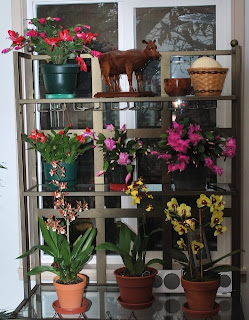
The west window is shaded by a deciduous tree. Lack of leaves lets in more light in winter. Leaves keep it cool in summer. Perfect place for my orchid "experiment" and epiphytic cacti.
I refinished the old table about 30 years ago. I've spent many years studying at this table - makes me feel at home. It belonged to my great aunt, and her parents, so is about 100 years old. Not a valid antique because I refinished it, but it's usable and has beautiful oak grain.
The plant stand and coffee table are glass top. Intentional - clean with some windex, no effort. The sofa folds out, in case there are guests. Now I have a bright, cheerful, comfortable, oganized place for the long hours of homework, as well as a guest bedroom and a place for my indoor garden. Cool!
The west window is shaded by a deciduous tree. Lack of leaves lets in more light in winter. Leaves keep it cool in summer. Perfect place for my orchid "experiment" and epiphytic cacti.
Thursday, November 05, 2009
Eggs / Schlumbergera / leaves
Day off today, lots of homework to do. Fortunatly I have my new home office for that.
The schlumbergera are budding profusely.
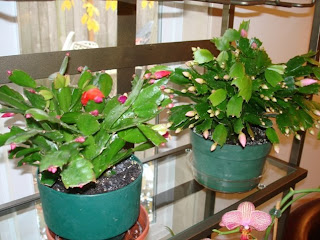
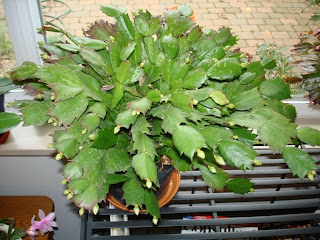
 I need to clean the chicken house. The poops are making stalactites under their roost. Here is yesterday's egg crop. Somebody didn't try very hard. The rest of the time they are all doing their little chicken jobs.
I need to clean the chicken house. The poops are making stalactites under their roost. Here is yesterday's egg crop. Somebody didn't try very hard. The rest of the time they are all doing their little chicken jobs.
The schlumbergera are budding profusely.
Monday, November 02, 2009
November 1 2009
Will plan on amending with some pics later.
One week ago I returned from 10 days in Southern China. I was about as far as it's possible to get from internet connection to work, and blogging sites were also blocked. There, I did get to see, first hand, a vanilla orchid farm (where vanilla beans are grown), and rice fields, tea, and coffee. Ning still has the camera, so I hope that photos will posted on his return in 3 weeks.
Meanwhile, here I've completed my home office / guest bedroom / pseudosolarium. Again, photos (maybe tonight). With an added West window, in addition to the current South window, the winter light will be as bright as I can make it. A bird feeder outside the window gives me something interesting to look at between computer entries. The orchids and holiday cacti are in the windows now, too.
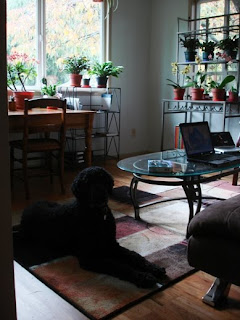

The schlumbergera (holiday cacti) are heavily budded. I hope that putting them into a different room doesn't cause bud drop. They look like they'll have the heaviest bloom since I started growing epiphytic cacti, about 6 years ago. The summer ouside did them good.
Last weekend I raked up leaves from my yard and my neighbor, whose house is for sale and he has moved out. Small leaves (dogwood, birch) which made for a good mulch over the bulb plantings. I had also planted another batch of Narcissus (Jetfire) and a red tulip mix. So this year I'm making up for not planting bulbs last winter.
One week ago I returned from 10 days in Southern China. I was about as far as it's possible to get from internet connection to work, and blogging sites were also blocked. There, I did get to see, first hand, a vanilla orchid farm (where vanilla beans are grown), and rice fields, tea, and coffee. Ning still has the camera, so I hope that photos will posted on his return in 3 weeks.
Meanwhile, here I've completed my home office / guest bedroom / pseudosolarium. Again, photos (maybe tonight). With an added West window, in addition to the current South window, the winter light will be as bright as I can make it. A bird feeder outside the window gives me something interesting to look at between computer entries. The orchids and holiday cacti are in the windows now, too.
The schlumbergera (holiday cacti) are heavily budded. I hope that putting them into a different room doesn't cause bud drop. They look like they'll have the heaviest bloom since I started growing epiphytic cacti, about 6 years ago. The summer ouside did them good.
Last weekend I raked up leaves from my yard and my neighbor, whose house is for sale and he has moved out. Small leaves (dogwood, birch) which made for a good mulch over the bulb plantings. I had also planted another batch of Narcissus (Jetfire) and a red tulip mix. So this year I'm making up for not planting bulbs last winter.
Sunday, October 11, 2009
October. Bulbs, new plant room, late harvests
As noted earlier, it's been difficult doing gardening, keeping up with the house, working working working, and looking after others. So here we are.
Currently, figs are ripening. During September, Hardy Chicago was very productive, with a few dozen figs. Now it's Petite Negri. Vancouver has a few, but they are getting moldy before they ripen. That did not happen before. Lattarula has a few - the first year ever! They are sweet, also seem to mold slightly on the outside when ripe, but not enough to matter.
I dried some figs, as well as some grapes. They taste so much better when grown at home and dried in a food dehydrator! I had no idea.
Many grapes remain, after eating many pounds of grapes. This has been a productive year for grapes as well.
Lots of apples now. They are pretty much all ripening.
A bedroom (actually junk-room) on the southwest corner of the house will become my home office and plant room. And guest bedroom. It will have a futon/sofa, a desk, and some plant stands in the windows. I added a western window; there is already a large south facing window. I took some photos but the current computer room is too cluttered for me work with them, so they'll have to be added later. I tore out the carpet last year. The floor was badly damaged and had a large plywood patch. I replaced the patch with oak flooring taken from a closet (that is being cannabilized for a bathroom), so it is authentic to the house. I sanded off the remaining finish from the floor, and now have given it 2 coats of polyurethane. It may need a third coat. Then new baseboard, paint the walls. It has a new light fixture already.
Then I can have the cacti and other plants in the south window. I'm trying some orchids, they can go in the shaded west window.
I planted about 100 daffodils and about 100 tulips. They'll help cheer up the winter, when they start poking through the ground in Feb and March.
 Most of the tulips were an unspecified tulip mix, but one package, planted under an old cherry tree, looks like this.
Most of the tulips were an unspecified tulip mix, but one package, planted under an old cherry tree, looks like this.
Daffodils included:
 Bella Estrella (Biltmore collection)
Bella Estrella (Biltmore collection)
 Vanilla Peach (Dutchbulbs.com)
Vanilla Peach (Dutchbulbs.com)
 Sunnyside Up (Dutchbulbs.com)
Sunnyside Up (Dutchbulbs.com)
 Replete (Dutchbulbs.com) - How did I end up with this one? I don't like "pink" daffodils!
Replete (Dutchbulbs.com) - How did I end up with this one? I don't like "pink" daffodils!
 Ice King (Biltmore Estates)
Ice King (Biltmore Estates)
I also decided to try, once again, to grow some Lycoris.
 Lycoris squamigera, photo from wikipedia. In the past, I've made several tries to grow Lycoris squamigera. These were traditional in my family, passed down through generations in the midwest. There, they were called "surprise lilies", and since I've heard them called "naked ladies" and "resurrection lilies". The leaaves grow in the Spring, then die off. In late Summer, the flower stems grow and bloom within a few days. I would love to have some. I've tried growing them here in the Northwest, without success. Internet research suggests that I'm planting them too deep. Most instructions state they should be 6 inches deep, but those seem to be based on the 'generic' bulb size. I found other instructions stating that they should only be covered up to their shoulders. So I'll give it a try. I also added a red variety, not the traditional family variety, Lycoris radiata, and a yellow one, Lycoris aurea.
Lycoris squamigera, photo from wikipedia. In the past, I've made several tries to grow Lycoris squamigera. These were traditional in my family, passed down through generations in the midwest. There, they were called "surprise lilies", and since I've heard them called "naked ladies" and "resurrection lilies". The leaaves grow in the Spring, then die off. In late Summer, the flower stems grow and bloom within a few days. I would love to have some. I've tried growing them here in the Northwest, without success. Internet research suggests that I'm planting them too deep. Most instructions state they should be 6 inches deep, but those seem to be based on the 'generic' bulb size. I found other instructions stating that they should only be covered up to their shoulders. So I'll give it a try. I also added a red variety, not the traditional family variety, Lycoris radiata, and a yellow one, Lycoris aurea.
 Lycoris aurea, photo from wikipedia.
Lycoris aurea, photo from wikipedia.
These have a different growth pattern, I think but the labels are contradictory.
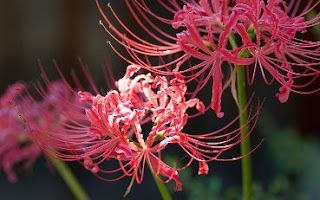 Lycoris Radiata, photo from wikipedia. The L. radiata already has small leaves. We'll see what they do this fall and winter.
Lycoris Radiata, photo from wikipedia. The L. radiata already has small leaves. We'll see what they do this fall and winter.
That's about all for now. I hope to get this blog going better once the home office is completed.
Currently, figs are ripening. During September, Hardy Chicago was very productive, with a few dozen figs. Now it's Petite Negri. Vancouver has a few, but they are getting moldy before they ripen. That did not happen before. Lattarula has a few - the first year ever! They are sweet, also seem to mold slightly on the outside when ripe, but not enough to matter.
I dried some figs, as well as some grapes. They taste so much better when grown at home and dried in a food dehydrator! I had no idea.
Many grapes remain, after eating many pounds of grapes. This has been a productive year for grapes as well.
Lots of apples now. They are pretty much all ripening.
A bedroom (actually junk-room) on the southwest corner of the house will become my home office and plant room. And guest bedroom. It will have a futon/sofa, a desk, and some plant stands in the windows. I added a western window; there is already a large south facing window. I took some photos but the current computer room is too cluttered for me work with them, so they'll have to be added later. I tore out the carpet last year. The floor was badly damaged and had a large plywood patch. I replaced the patch with oak flooring taken from a closet (that is being cannabilized for a bathroom), so it is authentic to the house. I sanded off the remaining finish from the floor, and now have given it 2 coats of polyurethane. It may need a third coat. Then new baseboard, paint the walls. It has a new light fixture already.
Then I can have the cacti and other plants in the south window. I'm trying some orchids, they can go in the shaded west window.
I planted about 100 daffodils and about 100 tulips. They'll help cheer up the winter, when they start poking through the ground in Feb and March.
 Most of the tulips were an unspecified tulip mix, but one package, planted under an old cherry tree, looks like this.
Most of the tulips were an unspecified tulip mix, but one package, planted under an old cherry tree, looks like this.Daffodils included:
 Bella Estrella (Biltmore collection)
Bella Estrella (Biltmore collection) Vanilla Peach (Dutchbulbs.com)
Vanilla Peach (Dutchbulbs.com) Sunnyside Up (Dutchbulbs.com)
Sunnyside Up (Dutchbulbs.com) Replete (Dutchbulbs.com) - How did I end up with this one? I don't like "pink" daffodils!
Replete (Dutchbulbs.com) - How did I end up with this one? I don't like "pink" daffodils! Ice King (Biltmore Estates)
Ice King (Biltmore Estates)I also decided to try, once again, to grow some Lycoris.
 Lycoris squamigera, photo from wikipedia. In the past, I've made several tries to grow Lycoris squamigera. These were traditional in my family, passed down through generations in the midwest. There, they were called "surprise lilies", and since I've heard them called "naked ladies" and "resurrection lilies". The leaaves grow in the Spring, then die off. In late Summer, the flower stems grow and bloom within a few days. I would love to have some. I've tried growing them here in the Northwest, without success. Internet research suggests that I'm planting them too deep. Most instructions state they should be 6 inches deep, but those seem to be based on the 'generic' bulb size. I found other instructions stating that they should only be covered up to their shoulders. So I'll give it a try. I also added a red variety, not the traditional family variety, Lycoris radiata, and a yellow one, Lycoris aurea.
Lycoris squamigera, photo from wikipedia. In the past, I've made several tries to grow Lycoris squamigera. These were traditional in my family, passed down through generations in the midwest. There, they were called "surprise lilies", and since I've heard them called "naked ladies" and "resurrection lilies". The leaaves grow in the Spring, then die off. In late Summer, the flower stems grow and bloom within a few days. I would love to have some. I've tried growing them here in the Northwest, without success. Internet research suggests that I'm planting them too deep. Most instructions state they should be 6 inches deep, but those seem to be based on the 'generic' bulb size. I found other instructions stating that they should only be covered up to their shoulders. So I'll give it a try. I also added a red variety, not the traditional family variety, Lycoris radiata, and a yellow one, Lycoris aurea. Lycoris aurea, photo from wikipedia.
Lycoris aurea, photo from wikipedia.These have a different growth pattern, I think but the labels are contradictory.
 Lycoris Radiata, photo from wikipedia. The L. radiata already has small leaves. We'll see what they do this fall and winter.
Lycoris Radiata, photo from wikipedia. The L. radiata already has small leaves. We'll see what they do this fall and winter.That's about all for now. I hope to get this blog going better once the home office is completed.
Friday, August 21, 2009
Kitchen Garden Log
Fresh tomatoes, peaches, peppers, and eggplant. I also picked 2-dozen pears yesterday - at the stage where they come loose from the tree when barely nudged.
Last weekend, we picked 1 dozen peaches from Honey Babe. Summer Gold isn't even close to ripe.
We have beans sprouting from last week's planting. Chinese pole beans and Romano.
August Iris Care
The clumps of bearded irises are becoming crowded and messy. I didn't weed or water them this summer. They are not hurt much, if at all, by the lack of watering. The weeds didn't grow much due to the same factor, but there were still enough to need maintenance.
August is the perfect time to dig up and replant irises in this area. It's dry enough that they shouldn't rot when replanted, while they become established and the ground settles again.
This group is in a very raised-bed, with a loosely built retaining wall. The bed is about 2 ft high, constructed due to a slope. It is filled with yard soil (clay/sand) mixed with compost.
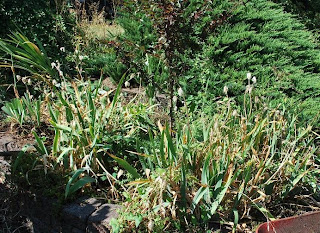 "Before" - This is the "found" variety, yellow standards with auburn falls. The ground was dry and loose, so they were fairly easy to dig.
"Before" - This is the "found" variety, yellow standards with auburn falls. The ground was dry and loose, so they were fairly easy to dig.
 I pulled out the weeds. That is much easier to do after digging the irises up. The leaves were trimmed, the oldest, deteriorating rhizomes cut off, and woven-together rhizomes were separated. In most cases, I separated down to 2 or 3 'fans' of leaves per new division.
I pulled out the weeds. That is much easier to do after digging the irises up. The leaves were trimmed, the oldest, deteriorating rhizomes cut off, and woven-together rhizomes were separated. In most cases, I separated down to 2 or 3 'fans' of leaves per new division.
 Soil was supplemented with generous amounts of chicken compost and crushed eggshells (for the calcium). Some additional soil was taken from the garden, to raise the level back near the top of the wall. The dark-leaf tree in the center is the Hollywood Plum, planted in February 2009. It's grown nicely.
Soil was supplemented with generous amounts of chicken compost and crushed eggshells (for the calcium). Some additional soil was taken from the garden, to raise the level back near the top of the wall. The dark-leaf tree in the center is the Hollywood Plum, planted in February 2009. It's grown nicely.
August is the perfect time to dig up and replant irises in this area. It's dry enough that they shouldn't rot when replanted, while they become established and the ground settles again.
This group is in a very raised-bed, with a loosely built retaining wall. The bed is about 2 ft high, constructed due to a slope. It is filled with yard soil (clay/sand) mixed with compost.
Subscribe to:
Posts (Atom)
